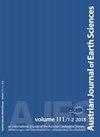The drowning of ancient Limyra (Southwestern Turkey) by rising groundwater during Late Antiquity to Byzantine times
IF 1.1
4区 地球科学
Q2 Earth and Planetary Sciences
引用次数: 3
Abstract
From the 6 th century BC to Byzantine times, the ancient city of Limyra was an important urban center of the Lycian territory at the southwestern coastal region of Asia Minor. Archaeological, geological, hydrochemical and surface elevation data, as well as 14 C age dating constrain a paleo-hydrogeological model, explaining the submergence of the city foundation walls below the groundwater table. In this model, tectonically induced subsidence of the acropolis (Tocak Dagi) initiated a debris flow into the area of the lower city. Both, natural and anthropogenic gravel accumulation resulted in the formation of a new aquifer pathway redirecting formerly bypassing karst water into the city center. Consequently, the inhabitants of Limyra had to fight against the rising ground water table at least since the 6 th to 10 th centuries AD. Die antike Stadt Limyra war vom 6. Jh. v.Chr. bis zu byzantinischer Zeit ein bedeutendes urbanes Zentrum in Lykien an der sud- westlichen Kuste von Kleinasien. Archaologische, geologische und hydrochemische Daten sowie ein Gelandemodell und ein 14 C Alter unterstutzen ein palao-hydrogeologisches Modell, welches das Absinken der Grundmauern der Stadt unter den Grundwasser- spiegel erklart. Das Modell beschreibt tektonisch induzierte Massenbewegungen vom Burgberg (Tocak Dagi) in die Unterstadt. Die naturliche und eine zusatzliche anthropogene Schuttanreicherung fuhrten zu einer Umleitung des ursprunglich vorbeifliesenden Grundwassers in das Stadtzentrum. Dies hatten die Bewohner von Limyra spatestens seit dem sechsten bis zehnten Jh. n. Chr. zu bewaltigen.古里拉(土耳其西南部)在上古晚期至拜占庭时期因地下水上升而被淹没
从公元前6世纪到拜占庭时代,利米拉古城是小亚细亚西南沿海地区利西亚领土的重要城市中心。考古、地质、水化学和地表高程数据,以及14c年代测定,约束了一个古水文地质模型,解释了城市基础墙淹没在地下水位以下的原因。在这个模型中,构造引起的雅典卫城(Tocak Dagi)的下沉引发了泥石流进入下层城市的区域。自然和人为的砾石堆积形成了一条新的含水层通道,将以前绕过喀斯特的水重新引导到城市中心。因此,至少从公元6至10世纪开始,利米拉的居民就不得不与不断上升的地下水位作斗争。从6月6日开始,叙利亚战争结束。Jh。v.Chr。在Lykien和der sud- westlichen Kuste von Kleinasien的拜占庭时代。考古学、地质学和水化学研究:在古水文地质模型中,在古水文地质模型中,在古水文地质模型中,在古水文地质模型中,在古水文地质模型中,在古水文地质模型中。[2]德国工业大学数学模型研究与应用。自然科学与人类科学的结合,人类科学与人类科学的结合,人类科学的发展。他说:“我的天哪,我的天哪,我的天哪!”n,空空的。祖茂堂bewaltigen。
本文章由计算机程序翻译,如有差异,请以英文原文为准。
求助全文
约1分钟内获得全文
求助全文
来源期刊

Austrian Journal of Earth Sciences
Earth and Planetary Sciences-Paleontology
CiteScore
3.10
自引率
0.00%
发文量
0
审稿时长
>12 weeks
期刊介绍:
AUSTRIAN JOURNAL OF EARTH SCIENCES is the official journal of the Austrian Geological, Mineralogical and Palaeontological Societies, hosted by a country that is famous for its spectacular mountains that are the birthplace for many geological and mineralogical concepts in modern Earth science.
AUSTRIAN JOURNAL OF EARTH SCIENCE focuses on all aspects relevant to the geosciences of the Alps, Bohemian Massif and surrounding areas. Contributions on other regions are welcome if they embed their findings into a conceptual framework that relates the contribution to Alpine-type orogens and Alpine regions in general, and are thus relevant to an international audience. Contributions are subject to peer review and editorial control according to SCI guidelines to ensure that the required standard of scientific excellence is maintained.
 求助内容:
求助内容: 应助结果提醒方式:
应助结果提醒方式:


